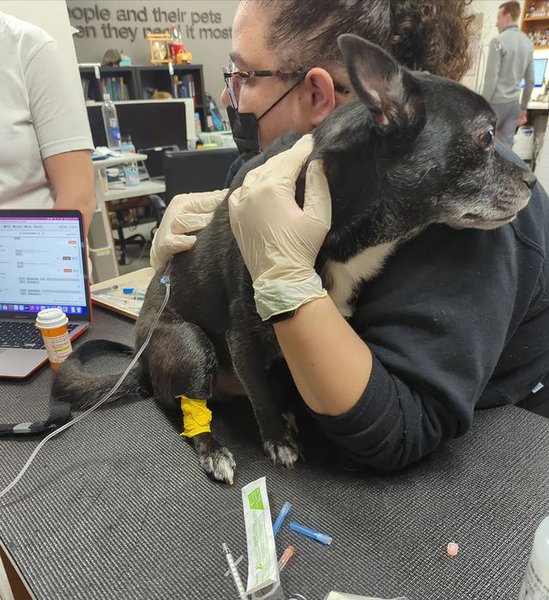Imagine your furry friend suddenly starting to act strangely, drinking water more often than usual, urinating incessantly, and passing bloody stools. Soon, your Fido can hardly stand and begins to lose weight and fur. Finally, after consulting a vet, your furry friend is diagnosed with Addison’s disease. You think only humans can get it, so you wonder what Addison’s disease in dogs is.
Addison’s disease, or “hypoadrenocorticism,” is a condition whereby a dog’s adrenal glands do not produce sufficient hormones, which the body requires, leading to health complications. Some signs to watch out for include alopecia hair loss, increased urination, increased thirst, dehydration, and shaking.
The thought of your doggie contracting this disease could be disheartening. But you should know that though potentially fatal, Addison’s disease can be medically managed with prompt diagnosis and therapy. This article reviews how vets diagnose Addison’s, common symptoms, and treatments for Addison’s disease in dogs. But first, let’s explore the causes of Addison’s disease in dogs.
What Causes Addison’s Disease In Dogs?

Addison’s disease is an autoimmune disorder that causes the dog’s immune system to view the adrenal glands as a threat. This stimulates the immune system to attack and damage the adrenal glands.
Secondary causes of Addison’s disease in dogs include destruction of the adrenal glands due to trauma, wrong medications, infections, congenital disorders, or cancers of the adrenal glands.
Vets also believe that medications for dogs with Cushing’s disease (hyperadrenocorticism) could also cause Addison’s disease.
This is because these drugs, which work by lowering cortisol and aldosterone production, may act excessively, leading to the condition. Additionally, a sudden withdrawal from steroid treatment can cause dogs to suffer from Addison’s disease.
Whatever negatively interferes with the adrenal gland causes it to stop producing aldosterone and cortisol. These hormones are highly essential for dogs.
What Triggers Addison’s Disease?
Triggers for Addison’s disease in dogs include intense stress, infection, and trauma.
Dogs are much more prone to developing Addison’s disease when any of these catalysts persist for long periods. So be careful to deal with any incident that can cause your dog inconvenience for a prolonged period, as this can put excessive stress on them.
Is Addison’s Disease In Dogs Caused By Stress?
No, stress cannot cause Addison’s disease in a healthy dog. When dogs are stressed, their adrenal glands produce cortisol to help them cope and counteract the effect.
But dogs with Addison’s have it worse when especially stressed, since the adrenal gland doesn’t produce sufficient stress-relieving hormones to buffer the effects. Hence, dogs may fall into crisis due to the sustained stress in their body.
Does Addison’s Disease In Dogs Come On Suddenly?
No, Addison’s disease does not come on suddenly in dogs. Instead, the disorder takes weeks or even months to develop, though the symptoms tend to appear suddenly and severely.
When symptoms become noticeable, a large part of the dog’s adrenal gland may already be affected and non-functional.
Can A Dog Be Born With Addison’s Disease?
There is no evidence proving that dogs can be born with Addison’s disease.
Meanwhile, recent studies show that there may be a genetic linkage between Addison’s disease and some dog breeds. For example, Addison’s disease may be highly inheritable in Standard Poodles and Bearded Collies. But these studies are not conclusive, and further investigations are needed.
What Dog Breeds Are Prone To Addison’s Disease?
All dog breeds of any age and gender can develop Addison’s disease. However, experts believe female dogs are more prone to the disease than male dogs.
Additionally, it has been suggested that Great Danes, Portuguese Water Spaniels, Rottweilers, Standard Poodles, West Highland White Terriers, Nova Scotia Duck Tolling Retrievers, Leonbergers, Labrador Retrievers, and Wheaten Terriers are more susceptible to Addison’s disease than other dog species.
What Are The Symptoms Of Addison’s Disease In Dogs?

Addison’s disease has several symptoms that can be confused with those of other ailments. These include lethargy, loss of appetite, loss of weight, increased thirst and urination, pale gums, seizures, lack of energy, and diarrhea.
Depending on the progression of the ailment, other signs of Addison’s disease in dogs are as follows:
- Bloody stool
- Skin pigmentation
- Shaking
- Irregular heart rate
- Weak pulse
- Hypoglycemia
Take your furry friend to the hospital quickly if you notice any of the above signs.
While many of these symptoms imitate several other dog ailments, you must not take chances. Dogs may suddenly collapse and need resuscitation or pass away in the worst cases.
Do Dogs With Addison’s Disease Drink A Lot Of Water?
Yes, dogs with Addison’s disease tend to drink water more than they would previously.
The frequent thirst and water drinking are effects of sodium or potassium imbalances, leading to a lack of water conservation by the dog’s kidneys.
Can A Dog Survive An Addisonian Crisis?
Yes, dogs can survive an Addisonian crisis if they get a prompt medical response.
An Addisonian crisis is a medical emergency characterized by sudden weakness, severe vomiting, diarrhea, and collapse. If you notice these symptoms, your dog needs immediate hospitalization and supportive treatment to survive the crisis.
Vets address the salt and fluid imbalances by putting the dog on a drip and giving them a steroid injection. Special medications are also provided to correct the dog’s abnormal heartbeat.
Is Addison’s Disease Fatal In Dogs?
Yes, Addison’s disease can be fatal in dogs if treatment does not commence early enough.
Some dogs may only show clinical signs of this condition once it has become dangerously advanced in their body. Hence, a crisis may be the first indicator of sickness, so a dog may die if this occurs in the owner’s absence.
How Long Does A Dog Live With Addison’s Disease?
Dogs with Addison’s disease can live their average life span if the condition is well-managed.
Note that managing Addison’s disease in dogs is a lifelong process. Knowing this, we advise you not to take your furry friend’s medication for granted. Instead, continue giving your dog medication even after your pooch appears healthy. This will help avoid a relapse in your furry friend.
How Do Vets Test For Addison’s Disease In Dogs?

Vets diagnose Addison’s disease in dogs through several methods, including checking the medical history, a thorough physical examination, and clinical tests.
Your veterinarian will perform tests to determine the general body functions. These tests include complete blood count (CBC), electrolyte levels, and urinalysis. Addison’s disease causes an imbalance in electrolyte levels and sometimes abnormalities in kidney values.
Another distinguishing factor between Addison’s disease and other ailments is that white blood cell production does not increase.
The definitive diagnostic method for Addison’s disease is the blood test known as the adrenocorticotropic hormone (ACTH) stimulation test.
The test involves injecting the sick dog with a hormone that should increase cortisol production. If a second blood examination reveals no increase in the cortisol level after this process, doctors can confirm that the canine has Addison’s disease.
At What Age Is Addison’s Disease Usually Diagnosed In Dogs?
Research shows that Addison’s disease is more common in middle-aged dogs between 3 and 6 years old.
However, young dogs, as early as 15 weeks, and seniors, up to 12 years old, can also develop Addison’s disease. That means there is no limit to the age for this sickness developing in dogs. But early to middle-aged dogs are the most reported for Addison’s disease.
How Is Addison’s Disease Treated In Dogs?
Treatment of Addison’s disease in dogs revolves around correcting electrolyte imbalance and acid-base disorders and replacing deficient hormones.
The treatment plan occurs in two phases: stabilizing your four-legged friend and follow-up therapy, which lasts your dog’s lifetime.
Stabilizing an Addisonian dog requires treatment with intravenous fluids and glucocorticoids. After your dog is considered stable, your doctor prescribes hormone-replacement medications for your furry friend.
Hormone-replacement medications may be pills or long-acting injections. Pills are usually administered daily, while injections can be every 21 or 25 days, as your vet prescribes.
The good part is that you may not need frequent visits to the clinic with your dog for further treatment after regaining a healthy status. Instead, with some training, you should be able to give the injections to your furry friend at home.
Most importantly, you must keep regular appointments with your vet. These scheduled visits let vets know how your dog is faring and allow them to conduct occasional tests that forestall future problems.
How Long Does It Take For A Dog To Recover From Addison’s Disease?
Dogs can recover from Addison’s disease after treatments of two to four weeks.
However, know that there is no permanent cure for Addison’s disease. Treatments are only to manage the condition and will continue throughout an affected dog’s lifetime.
Hormone-replacement therapies and regular blood tests to check hormone and electrolyte levels will occur monthly or at other schedules determined by the vet.
How Much Does It Cost To Treat Addison’s Disease In Dogs?

The treatment cost of Addison’s disease in dogs varies from $100 to $250 monthly.
Generally, treatment costs depend on the severity of the ailment before discovery. The complete set of tests for dogs may cost between $600 and $2,000. In addition, you may require between $500 and $1,000 daily until your pup’s health stabilizes.
Overall, treatment of Addison’s disease is costly. There are drugs to buy monthly and tests to undergo throughout your furry friend’s lifetime.
How Do You Treat Addison’s Disease In Dogs Naturally?
Natural treatments for Addison’s disease include feeding dogs with whole animal tissues, supplements of adrenal-gland extract, natural antioxidants, and some herbal remedies.
Some herbal remedies that can improve the overall health of your furry canine’s adrenal gland include:
- Borage
- Dandelion leaf
- Licorice
- Nettle
- Spirulina
- Siberian Ginseng and Huang qi
- Oatstraw
- German chamomile
These herbs function differently to reduce stress, stimulate hormone production, and improve dogs’ overall health.
What Should A Dog With Addison’s Disease Eat?
Dogs with Addison’s disease should eat raw or fresh-food diets more often.
Such dogs would benefit from eating the following:
- High-protein foods, such as lean meats, fish, eggs, dairy, nuts, and legumes
- An antioxidant-rich diet with leafy greens and colorful vegetables
- Carbohydrates like whole grains
- Low-sugar fruits
- Healthy fatty foods like olive oil and avocado
Probiotics are also an excellent addition to dogs’ diets to help improve their immune system and aid digestion.
Generally, dogs with Addison’s disease should eat nutrient-rich meals, whether raw, cooked, or processed.
What Is The Opposite Of Addison’s Disease In Dogs?
Cushing’s disease (hyperadrenocorticism) is the opposite of Addison’s disease (hypoadrenocorticism).
In Cushing’s disease, the adrenal glands produce more cortisol than a dog needs, putting them at risk of other severe conditions like kidney damage and diabetes.
Is Addison’s Disease The Same As Cushing’s In Dogs?

No, Addison’s disease is not the same as Cushing’s disease in dogs.
Both ailments are opposites rather than alike. The only similarity between Cushing’s and Addison’s disease is that both are adrenal-gland problems.
While the adrenal glands cannot produce crucial hormones like cortisol, aldosterone, and adrenaline in Addison’s disease, they do so excessively in Cushing’s disease.
Again, both can be life-threatening if not treated early. Therefore, early detection is essential to increase a dog’s chances of survival with either or both conditions.
What Is Similar To Addison’s Disease In Dogs?
Trichuris vulpis infection has similar symptoms to Addison’s disease but different causes.
When Trichuris vulpis, or “whipworm,” multiplies in a dog’s large intestine, it continuously stimulates, and eventually damages the mucosa as it searches for worms and fluids. As a result, the dog experiences hemorrhagic colitis.
Research shows that the Trichuris vulpis worm is the only nematode associated with pseudo-Addison disease. Such an infection causes dysorexia, weakness, weight loss, and other symptoms of Addison’s disease.
Upon examination, the sick dog would also show electrolyte imbalance. Still, an ACTH Stimulation Test would reveal nothing is wrong with the adrenal gland.
A centrifugation flotation fecal analysis will reveal the eggs of these worms, confirming their presence. Treatments can then commence, and the dog will regain health in a few days.





